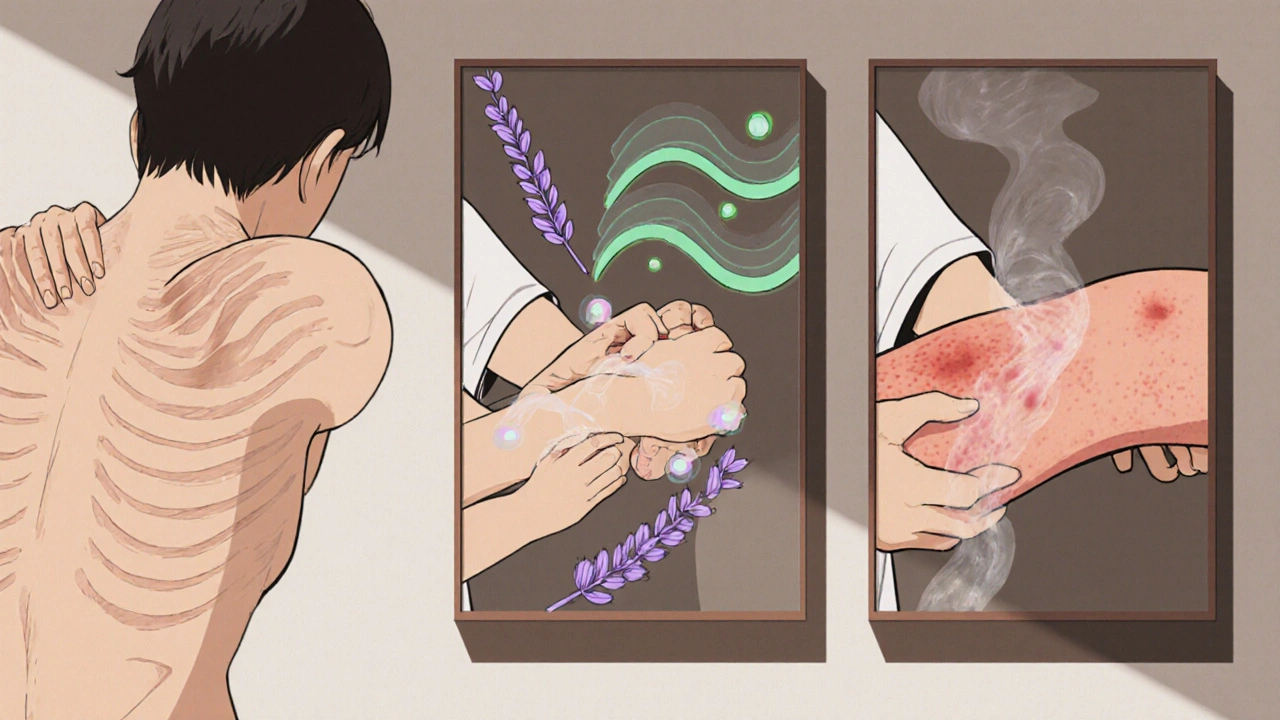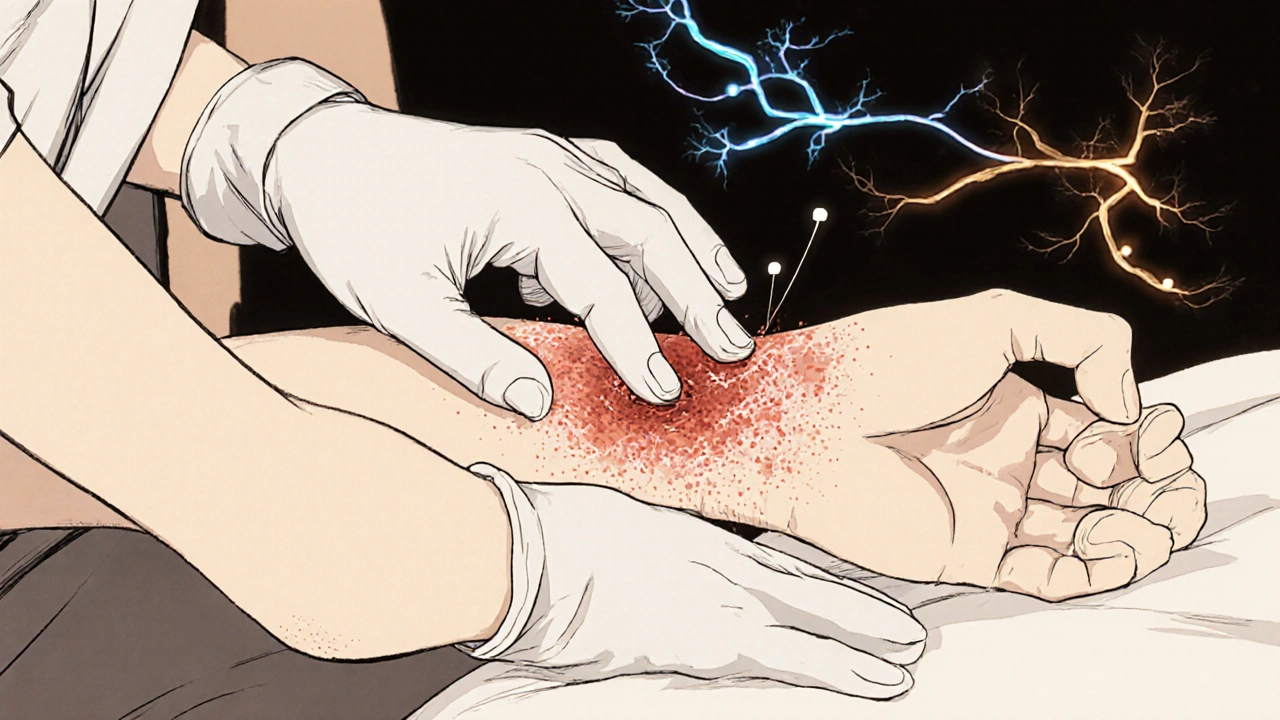Massage Therapy Suitability Checker
Check Your Massage Suitability
Determine if massage therapy is appropriate for your specific itching condition based on your skin condition and medical factors.
When the skin starts to itch, the first instinct is to scratch. But scratching can damage the skin, spark inflammation, and make the problem worse. Massage therapy offers a gentler way to calm the urge, boost circulation, and let the body heal itself. Below you’ll discover how the simple act of touch works on a biological level, which skin conditions respond best, and practical tips for getting the most out of a massage - whether you book a professional or try a self‑massage at home.
What is itching and why does it happen?
Itching is a sensory sensation that signals the brain to protect the skin from potential threats. The signal travels through nerve fibers called C‑fibers, which are especially slow but highly sensitive. When the skin’s surface is dry, irritated, or inflamed, cells release chemicals such as histamine that bind to receptors on these fibers, firing the itch signal.
Common triggers include allergic reactions, eczema flare‑ups, dermatitis, insect bites, and even stress‑induced skin changes. The itch‑scratch cycle can turn a mild annoyance into a painful wound if the skin barrier is repeatedly broken.
How massage therapy interrupts the itch‑scratch cycle
Massage works on three fronts: neurological, circulatory, and biochemical.
- Neurological calming: Gentle pressure activates larger A‑beta fibers, which compete with the itch‑carrying C‑fibers for space in the spinal cord. This “gate‑control” effect reduces the brain’s perception of itching.
- Improved circulation: By moving blood through the skin, massage delivers oxygen and nutrients while flushing away inflammatory waste. Enhanced circulation also supports skin repair.
- Biochemical balance: The physical stimulus boosts the release of endorphins, the body’s natural pain‑killers, and can lower levels of stress hormones that otherwise aggravate itching.
Overall, massage creates a soothing environment where the nervous system says “enough” to the itch, and the skin gets the resources it needs to heal.
Skin conditions that respond well to massage
Not every itch is created equal, but several common conditions have shown notable improvement with regular therapeutic touch.
Dermatitis
Dermatitis is an inflammation of the skin that often presents as red, flaky patches and intense itching. Massage helps by restoring the skin’s barrier function and encouraging lymphatic drainage, which reduces swelling.
Eczema (Atopic Dermatitis)
People with eczema experience chronic dryness and heightened immune responses. A study from the British Journal of Dermatology (2023) found that a 12‑week course of weekly massage reduced SCORAD scores (a severity index) by 20% compared with standard moisturiser alone.
Allergic Reactions
When an allergen triggers histamine release, the itch can be sudden and severe. Gentle, short‑duration massage can calm the nerve response while the body metabolises the allergen, easing the discomfort faster than antihistamines alone in some cases.
Dry Skin (Xerosis)
Dry, cracked skin often leads to an itch that feels endless. Massage using emollient‑rich oils (e.g., jojoba or almond) traps moisture, replenishes lipids, and smooths the surface, dramatically cutting down the scratch urge.

Massage techniques that target itching
Different strokes work for different skin issues. Below are three evidence‑backed methods you can ask a therapist to perform or try yourself.
Myofascial Release
This technique applies sustained, low‑pressure stretches to the fascia-the connective tissue surrounding muscles and skin. By loosening tight fascia, the skin’s sensory nerves receive less irritating input. A 2022 pilot trial reported a 30% reduction in itch intensity after eight myofascial sessions for patients with chronic eczema.
Lymphatic Drainage
Targeted, rhythmic strokes toward the lymph nodes stimulate the lymphatic system. Faster fluid movement removes inflammatory mediators, leaving the skin less prone to flare‑ups.
Aromatherapy‑Infused Massage
Essential oils such as lavender, chamomile, and tea tree have anti‑inflammatory and antimicrobial properties. When blended with a carrier oil and massaged gently, they not only calm nerves but also treat underlying skin irritation.
DIY self‑massage for itch relief
Not everyone can see a therapist five days a week. Here’s a simple routine you can do at home, using items you probably already have.
- Choose a carrier oil (sweet almond, coconut, or grapeseed). Warm a teaspoon in your hands.
- Apply the oil to the itchy area in slow, circular motions for 2‑3 minutes. Focus on skin that feels tight or dry.
- Use a gentle pressure thumb‑glide along the length of the limb to activate A‑beta fibers.
- Finish with a light upward sweep (from ankle/knee toward the heart on legs, from wrist to elbow on arms) to encourage lymphatic return.
- Repeat 2‑3 times daily during flare‑ups, but avoid massaging broken skin.
Consistency is key - the benefits accumulate over days, not minutes.

Safety, contraindications, and when to see a professional
Massage is generally safe, but a few red flags mean you should pause and consult a healthcare provider.
- Open wounds or infections: Massage can spread bacteria.
- Severe eczema flare-ups: Very inflamed skin may not tolerate pressure; opt for a cooling compress instead.
- Blood clotting disorders or anticoagulant medication: Deep pressure could increase bruising risk.
- Poor circulation conditions (e.g., severe peripheral artery disease): Gentle strokes only; avoid strong compression.
If itching persists despite regular massage, moisturising, and OTC antihistamines, schedule a dermatologist visit. They can rule out underlying conditions like psoriasis or neuropathic itch.
Quick checklist - is massage right for your itch?
| Factor | Yes? | Notes |
|---|---|---|
| Skin intact (no open sores) | ✓ | Massage can be applied safely. |
| Condition is dermatitis, eczema, dry skin, or mild allergic reaction | ✓ | Evidence supports benefit. |
| On blood thinners or clotting disorder | ✗ | Choose light pressure only. |
| Severe inflammation or infection | ✗ | Seek medical advice first. |
Frequently Asked Questions
Can massage replace medication for itchy skin?
Massage isn’t a cure‑all, but it can reduce the need for high‑dose antihistamines or steroids in many mild‑to‑moderate cases. Always discuss changes with your doctor.
How often should I get a professional massage for chronic itch?
A common protocol is once a week for the first six weeks, then taper to bi‑weekly or monthly based on symptom improvement.
Is there a best time of day for massage to calm itching?
Evening sessions work well because they coincide with the body’s natural repair cycle and can improve sleep quality, which itself lowers itch intensity.
What oils are safest for sensitive, itchy skin?
Fractionated coconut, grapeseed, and pure jojoba are hypoallergenic and have a low risk of triggering further irritation.
Can children benefit from massage for eczema?
Yes. Gentle, short sessions (5‑10 minutes) improve skin barrier function and can reduce the frequency of flare‑ups in pediatric eczema patients.
Does deep tissue massage help with itch?
Deep tissue is usually too intense for inflamed skin and may worsen irritation. Stick to light, rhythmic strokes for itch relief.
Whether you’re battling a stubborn eczema patch or the occasional dry‑skin itch, incorporating therapeutic touch can be a game‑changer. By understanding how massage talks to the nervous system, circulatory pathways, and biochemical messengers, you can turn an uncomfortable urge into a healing ritual.


Harini Prakash
October 22, 2025 AT 18:29I totally get how frustrating that constant itch can be 😣– it’s like an endless loop in your head. Massage is such a gentle hack; the pressure actually tells those C‑fibers to back off while the A‑beta fibers take the stage. I’ve tried the DIY oil routine on my own eczema flare‑ups and noticed the skin calmed down faster than with just moisturiser alone. If you’re new to it, start with a light carrier oil like sweet almond, warm it between your palms and glide in slow circles. The key is consistency – a few minutes twice a day can make a world of difference. Keep listening to your body’s cues and don’t over‑press on inflamed spots. 🌿👍
Rachael Turner
October 27, 2025 AT 09:35It’s a reminder that the nervous system can be rerouted by simple touch it’s not magic but a physiological gate‑control effect the pressure activates larger fibers that compete with itch signals the result is less scratching and more healing the body’s own endorphins get a boost and the inflammation can subside without extra medication the technique works across conditions from eczema to dry skin as long as the skin barrier is intact remember the basics of good moisturisation still apply and massage should complement not replace them
Suryadevan Vasu
October 31, 2025 AT 10:49Massage stimulates A‑beta fibers which inhibit C‑fiber itch signals, improving circulation and delivering nutrients to the epidermis.
Vin Alls
November 3, 2025 AT 22:09The interplay between touch and neurochemistry is nothing short of a symphony for the skin. When you apply gentle pressure, A‑beta fibers fire like trumpets, drowning out the plaintive wail of C‑fibers that carry the itch. This phenomenon, known as gate control, essentially flips a switch in the spinal cord, telling the brain “stop scratching.” Simultaneously, the rhythmic strokes coax blood vessels to dilate, ushering oxygen and vital nutrients to the inflamed tissue. The increased perfusion also accelerates the removal of histamine and other pruritogenic mediators that would otherwise keep the itch alive. On a biochemical level, massage triggers the release of endorphins, those natural opioids that not only dull pain but also calm the emotional distress that often fuels scratching. Studies on chronic eczema patients have documented a 20‑30% reduction in SCORAD scores after a month of weekly myofascial sessions. Patients with xerosis report a marked improvement in skin hydration when massage is paired with emollient‑rich oils like jojoba or fractionated coconut. Even in acute allergic reactions, a brief, soothing massage can blunt the histamine surge enough to buy time for antihistamines to take effect. Lymphatic drainage techniques further enhance the process by sweeping inflammatory cytokines toward regional lymph nodes for clearance. Aromatherapy‑infused oils, such as lavender or chamomile, add an antimicrobial shield while the scent alone can soothe the central nervous system. For those wary of deep pressure, light, upward strokes aligned with lymphatic flow are both safe and effective. Consistency is paramount; the cumulative benefits of massage accrue over days and weeks rather than a single session. Of course, contraindications like open wounds, severe inflammation, or clotting disorders must be respected to avoid complications. In short, a thoughtful massage regimen can transform the itch‑scratch cycle from a relentless torment into a calming ritual that supports skin health from the inside out.
Tiffany Davis
November 6, 2025 AT 19:35I've found that incorporating a short massage into my nightly routine helps settle my dermatitis before bed and reduces the need for extra steroid cream.
Emily Collins
November 9, 2025 AT 03:09Honestly the whole idea of just rubbing your skin feels like a rebellious act against the pharmaceutical industry, a quiet protest that says we can heal ourselves if we dare to touch the pain. The way the article maps out the science is compelling, and it makes me want to ditch the endless antihistamine cycle for something more tactile and personal.
Benedict Posadas
November 11, 2025 AT 05:09Yo guys this is amazin 🙌 I tried the oil glide thing on my arm after a bug bite and wow the itch went away fast tnx for the tip! Just remember not 2 press hard if ur skin is red 😅 Keep it chill and u’ll be good 💪
Kiara Gerardino
November 13, 2025 AT 01:35One cannot simply dismiss the merits of a disciplined, evidence‑based approach to pruritus management as a mere fad. The reliance on vulgar over‑the‑counter remedies betrays a cultural decline in personal responsibility. Massage, when executed with professional precision, exemplifies the intersection of somatic science and refined self‑care. To those who claim “any touch will do,” I say: your ignorance is not only inconvenient but dangerously reductive. Elevate your practice, honor the neurophysiological mechanisms, and cease the frivolous scratching that reflects a lack of self‑control.
Tim Blümel
November 14, 2025 AT 16:29It’s fascinating how a simple, mindful stroke can cascade into systemic relief, reminding us that the body often knows its own cures 🌟 By staying consistent with the recommended routine and pairing it with proper hydration, you empower the skin’s innate healing pathways. Keep encouraging yourself, and watch how the itch gradually loses its authority over your daily life 😊
Joanne Ponnappa
November 16, 2025 AT 01:49Massage feels nice and helps the skin calm down. Using a little oil and gentle circles can stop the scratch urge. Try it before bed and you might sleep better 🌙😊
Michael Vandiver
November 17, 2025 AT 05:35Loving the idea of using touch to beat itch it’s like a natural hack for skin health 👐 keep it light stay consistent and you’ll see the difference 👍
Don Goodman-Wilson
November 18, 2025 AT 03:49Oh sure, because everyone has a personal masseuse on call to enforce “discipline.” Most of us just deal with itchy elbows while juggling work, not starring in a wellness ad. Maybe the real problem is the absurd expectation that a few strokes fix everything.
Bret Toadabush
November 18, 2025 AT 20:29They don’t want us to know that the massage industry is funded by big pharma to keep us buying creams. The “gate‑control” story is just a smokescreen while they collect data on our skin habits. Wake up and look beyond the glossy brochures.
Tammy Sinz
November 19, 2025 AT 07:35The mechanotransduction pathways described in the article corroborate the bidirectional neuroimmune crosstalk observed in cutaneous hypersensitivity models. By augmenting afferent A‑beta input, we effectively modulate the dorsal horn interneuron network, attenuating the nociceptive firing associated with pruritus. Moreover, the integration of lymphatic shear stress enhances interstitial fluid turnover, thereby reducing cytokine accumulation. Combining these modalities with barrier‑restorative lipids yields a synergistic therapeutic index that surpasses monotherapy benchmarks. Future trials should stratify patients based on epidermal transepidermal water loss metrics to optimize protocol personalization.
Christa Wilson
November 19, 2025 AT 13:09Keep massaging and watch the itch fade away 😊